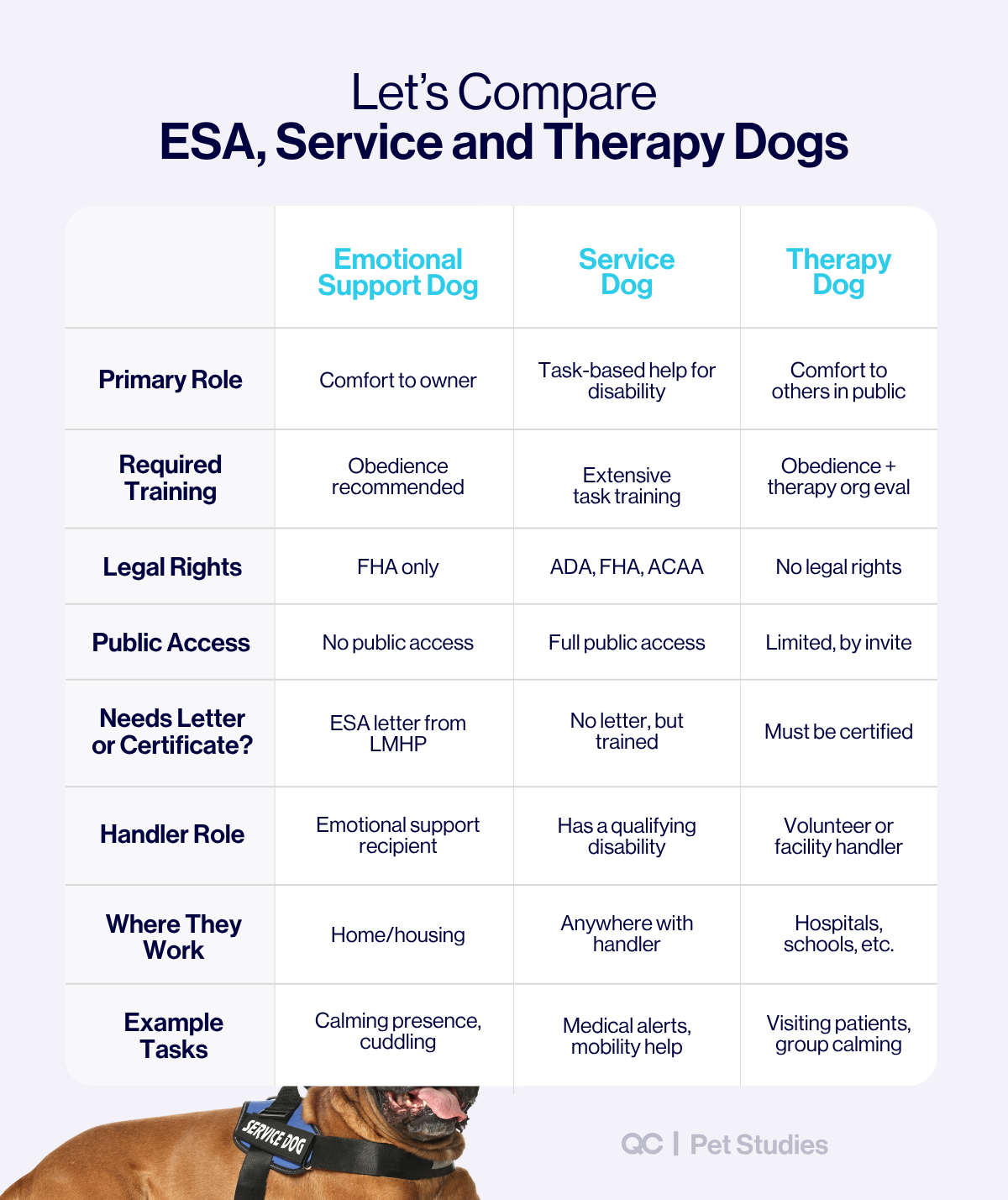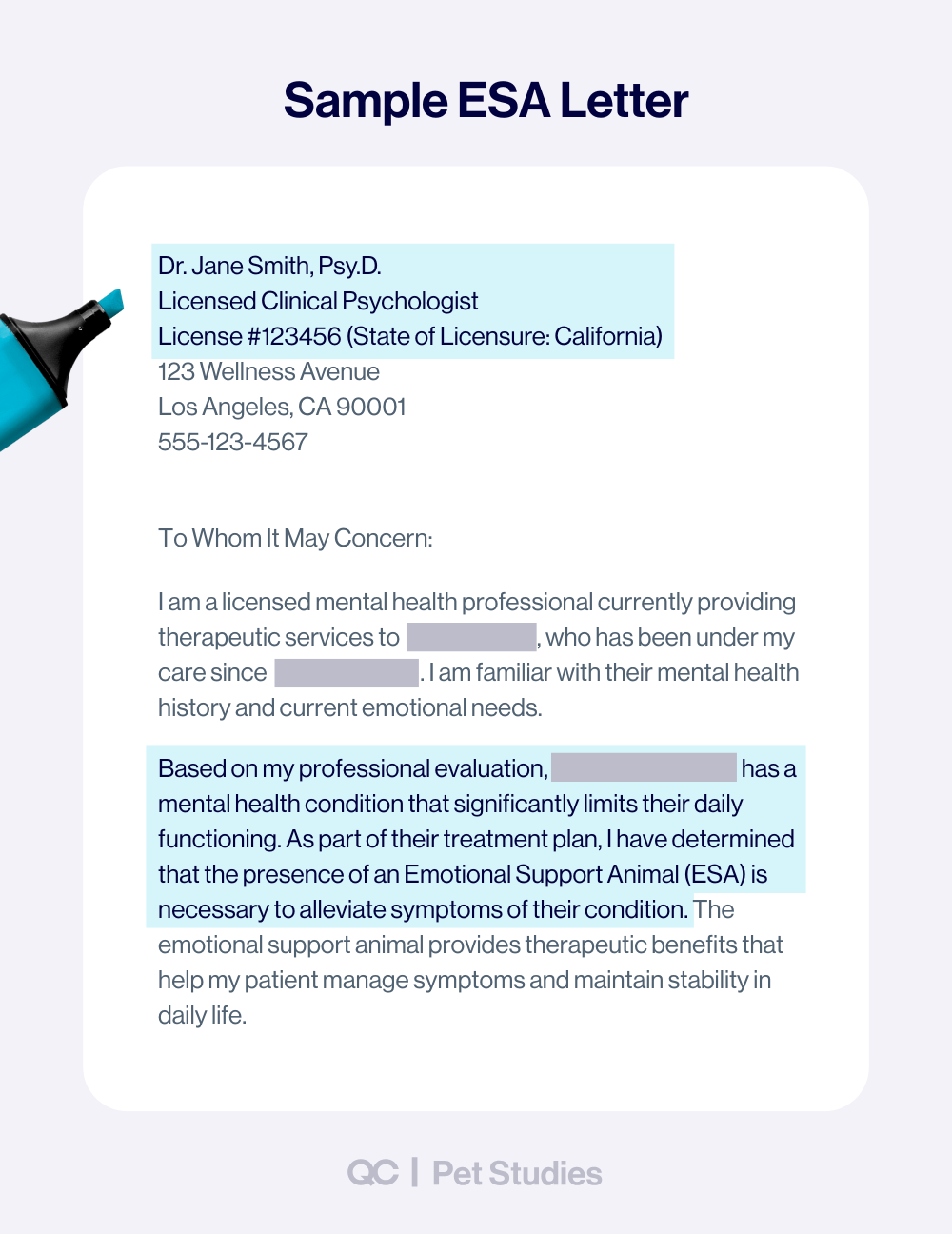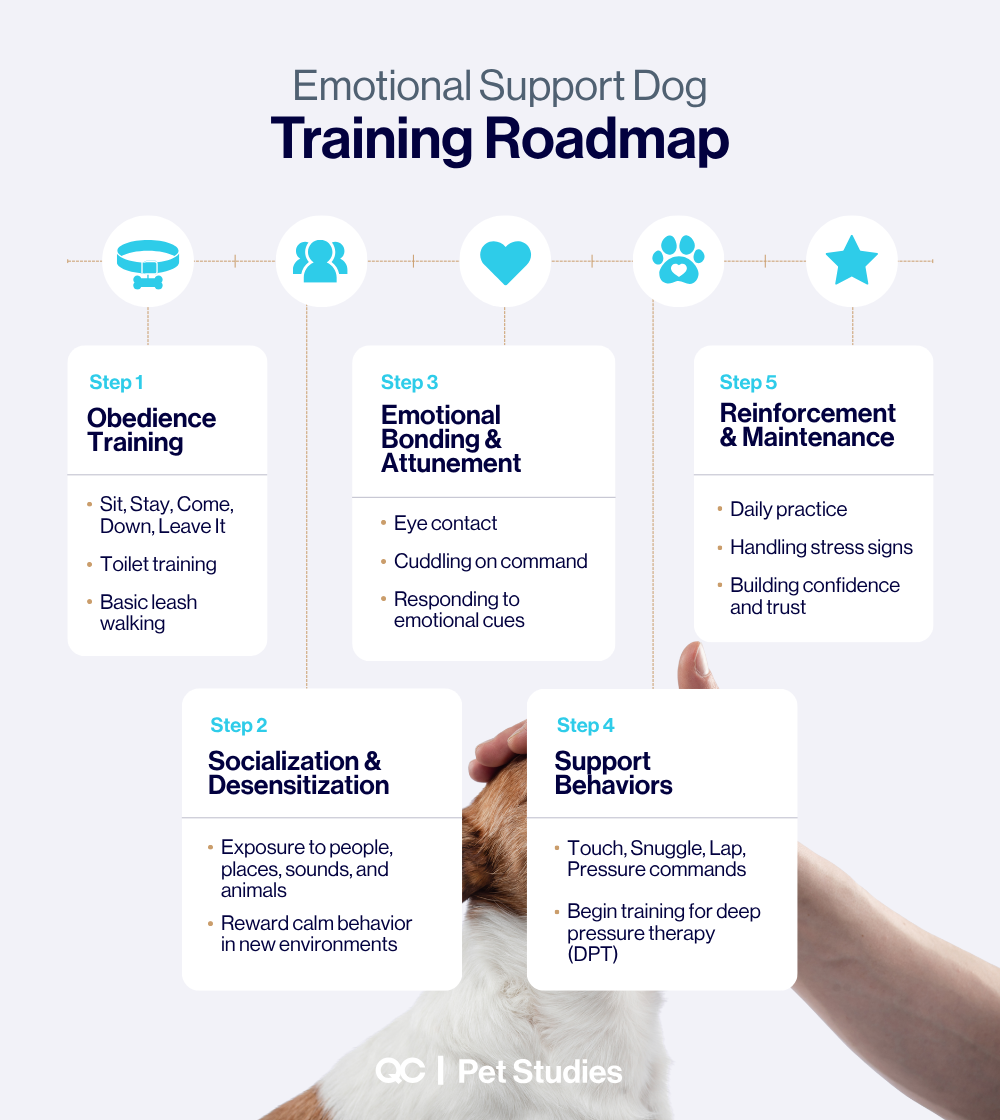Emotional Support Dog Training Key Points
- ESD training is a growing field with increasing demand for skilled trainers.
- Certification, like QC Pet Studies, builds credibility and attracts clients.
- Training an ESD takes 3–6 months, focusing on obedience and emotional cues.
- ESA training differs from service dog training, requiring specialized knowledge.
- QC Pet Studies’ certification provides the foundation and skills to become an ESA trainer.
Introduction
Emotional support dogs (ESDs) play a vital role in supporting individuals living with mental health challenges. For aspiring and professional dog trainers alike, understanding how to properly train these animals is essential to making a meaningful impact. This guide covers the fundamentals of emotional support dog training, outlines key training steps, and explores how to build a career helping others prepare their dogs to become effective emotional support animals.
Keep reading to discover how emotional support dog training can change lives, and how trainers can turn their skills into a rewarding, purpose-driven profession!
Emotional support dog training prepares dogs to provide emotional comfort and stability to individuals with mental health conditions. These dogs are not expected to perform tasks like service dogs, nor interact with the public like therapy dogs. Instead, they offer personal, emotional support in their owner’s life.
Emotional Support Dog vs. Service Dog Training vs. Therapy Dog Training
Let’s clear up the confusion between these three important roles:
- Emotional Support Dogs (ESDs): Provide emotional comfort, protected under the Fair Housing Act, require an ESA letter, not allowed in public places.
- Service Dogs: Perform specific tasks for disabilities, granted full public access under ADA, require formal training.
- Therapy Dogs: Comfort people in public settings, require certification, no public access rights like service dogs.

Understanding these distinctions ensures that readers pursuing emotional support dog training aren’t misled into thinking they’re preparing for public-access service or therapy dog work. Emotional support dogs are for private, individual support. This is what makes them such a wonderful opportunity for dog owners and aspiring trainers alike!
How to Become an Emotional Support Dog Trainer
Here’s the good news: emotional support dog training is currently an unregulated field. This means that there’s no government-mandated license or board certification required to become a trainer.
However, that does NOT mean anyone can succeed without preparation. To build trust, attract clients, and ensure safe and ethical training, you’ll need to invest in education, experience, and professional credibility.
The ideal qualifications include:
- A formal dog training course from a recognized institution (like QC Pet Studies)
- Understanding of canine psychology and learning theory
- Knowledge of emotional support dog laws, boundaries, and expectations
- Experience with basic obedience, socialization, and emotional attunement techniques
- The ability to work compassionately with individuals experiencing anxiety, PTSD, or depression
💡 QC Pet Studies’ online Dog Training Course is a great way to build the skills and confidence needed to start your career as an emotional support dog trainer!
(Psst! Keep reading, because later, we delve even further into what it takes to become an emotional support dog trainer!)
Become a Certified Dog Trainer
Train from the comfort of home and graduate in as little as 3-6 months!
Understanding ESA Eligibility for Your Clients
Emotional support animals are intended to assist individuals managing specific mental health conditions that significantly interfere with daily life. As an emotional support dog trainer, it’s important to understand the eligibility requirements so you can properly guide clients through the process.
Common qualifying conditions include:
- Generalized anxiety disorder
- Depression
- PTSD (post-traumatic stress disorder)
- Panic disorders
- OCD (obsessive-compulsive disorder)
- Phobias
- Social anxiety
- Bipolar disorder
To legally qualify for an emotional support animal, clients must obtain an official ESA letter from a licensed mental health professional (LMHP). This letter confirms that the presence of the animal provides necessary emotional or psychological support and is part of the individual’s overall wellness plan.
Trainers should not provide this documentation themselves. That said, they should be prepared to explain the importance of it and refer clients to legitimate resources if needed. Understanding these legal and ethical boundaries will help maintain your professionalism and protect your clients from misinformation.
What Is an ESA Letter?
An ESA letter is a legally recognized document that:
- States the individual has a qualifying mental or emotional disability
- Recommends an emotional support animal as part of treatment
- Includes the LMHP’s license number, contact information, and signature
- Must be written on the provider’s official letterhead

Legal Rights and Limitations of Emotional Support Dogs
One of the most common misconceptions about emotional support dogs (ESDs) is that they have the same public access rights as service dogs. As a trainer, it’s important to educate clients on the actual legal protections and limitations associated with ESAs—especially when they’re preparing to advocate for their rights in housing or therapeutic contexts.
While emotional support animals serve a vital role in supporting mental health, they are not granted access to public spaces such as restaurants, stores, or airplanes. Their legal protections are specific and primarily limited to housing.

Where Can ESAs Go?
This is one of the most important distinctions to understand when training emotional support dogs. After all, educating your clients or students on these legal facts is just as important as teaching sit and stay. Responsible ESA ownership starts with informed expectations.

Where Emotional Support Dogs Are Allowed (by law):
- Housing: Protected under the Fair Housing Act (FHA), landlords must make reasonable accommodations for tenants with a valid ESA letter—even in pet-free buildings.
- College Dorms and Campus Housing: Also covered under the FHA.
- Workplaces: In some cases, employers may accommodate ESAs, but this is handled on a case-by-case basis and is not legally required.
Where Emotional Support Dogs Are Not Legally Permitted:
- Restaurants
- Stores
- Malls
- Public transportation (unless permitted by company policy)
- Airplanes (see below)
- Hotels (unless ESA-friendly by policy)
What Makes a Good Emotional Support Animal?
Not all dogs are suited for emotional support work. Ideal ESAs should have these traits:
- Calm and composed in new situations.
- Affectionate and eager to comfort.
- Trainable and responsive to commands.
- Non-aggressive with people and other animals.
- Confident, not overly timid.
Dogs naturally attuned to human emotions make great ESAs. That said, ANY dog with the right temperament can excel.
The Ideal Emotional Support Dog: Temperament and Traits
Not every dog is cut out to be an emotional support animal (ESA)—and that’s okay. While any breed can qualify, the dog’s personality, behavior, and emotional sensitivity are far more important than pedigree. This section helps you (or your future clients) understand what to look for in a great ESA candidate before beginning emotional support dog training.

Best Breeds for Emotional Support
While any breed can become an emotional support dog, these breeds are often ideal:
- Labrador Retriever: Friendly, patient, and emotionally in tune with their owners.
- Golden Retriever: Calm, obedient, and deeply affectionate—ideal for emotional bonding.
- Poodles (and Doodles): Intelligent, hypoallergenic, and easily trainable.
- Cavalier King Charles Spaniel: A small breed that thrives on close contact and companionship.
- Havanese: Gentle lap dogs that adapt well to small spaces and provide great comfort.
- Mixed Breeds: Many rescue dogs have the perfect disposition and can make phenomenal ESAs.

How to Evaluate a Client’s Dog for Emotional Support Work
Before beginning emotional support dog training, it’s important to assess whether the client’s dog has the right temperament and foundational behaviors for the role. While many dogs can develop into excellent ESAs with proper training, some core traits and behaviors should already be present.
Thus, use the following checklist as a professional screening tool:
- Responds reliably to basic obedience cues (sit, stay, come)
- Is fully house-trained
- Shows no signs of aggression or reactivity toward people or other animals
- Demonstrates nurturing behavior when someone is upset or anxious
- Remains calm in moderately noisy or unfamiliar environments
- Seeks and enjoys physical closeness (e.g., cuddling, resting near their handler)
If a dog meets most of these criteria, they may be a strong candidate for emotional support work. As a trainer, your job is to help reinforce and shape these tendencies through structured, goal-oriented training that aligns with the handler’s emotional needs.
What Training Does a Dog Need To Be an Emotional Support Animal?
While emotional support animals (ESAs) are not legally required to complete formal training, a well-structured training plan is essential to ensure the dog can provide reliable comfort and behave appropriately in various environments. For professional dog trainers, guiding clients through this process means focusing on both behavioral reliability and emotional attunement.
Step-by-Step ESA Training Plan
Training an emotional support dog should follow a phased approach, with each stage reinforcing the dog’s ability to remain calm, focused, and connected to their handler. Below is a professional-grade roadmap to follow when working with clients and their dogs:
Phase 1: Foundation – Obedience and Routine
Start by establishing essential obedience skills and consistent routines. These fundamentals lay the groundwork for mutual trust between the dog and handler. Furthermore, they are especially important for dogs who will be offering emotional support in shared or sensitive environments.
Core skills to instill at this stage include:
- Sit
- Stay
- Come
- Down
- Leave it
- Heel (on leash)
- Name recognition
- Crate training and toilet training
Trainers should coach clients on how to use positive reinforcement methods, emphasizing short, focused training sessions. The goal is to create a dog that is responsive, confident, and well-regulated—while also fostering a strong emotional bond with its handler.
Avoid aversive techniques or punishment-based approaches, as these can damage trust and compromise the dog’s ability to serve as a calming presence.
Phase 2: Socialization and Desensitization
Next, emotional support dogs must be calm, confident, and reliable in a variety of everyday environments. As such, trainers should guide clients through structured socialization and desensitization exercises that reinforce calm behavior and build emotional resilience.
Recommended exposure scenarios include:
- A variety of people (diverse ages, appearances, energy levels);
- Other dogs and animals (on-leash, safe, and controlled introductions);
- Busy or unpredictable environments (parks, urban sidewalks, parking lots);
- Common household and public sounds (vacuum cleaners, sirens, loud doors, clanging carts).
The goal is to help the dog interpret novelty as neutral or positive—not threatening.
Phase 3: Emotional Attunement and Bonding
This phase introduces the emotional work expected of an ESA. Trainers can help clients cultivate strong bonds with their dogs and begin shaping behavior that aligns with emotional responsiveness.
Key behaviors to train include:
- Eye contact on cue (e.g., “look at me”) to reinforce focus and connection;
- Cuddling or lap resting on command, creating associations with closeness and calm;
- Responding to emotional cues, such as approaching when a handler is crying, shaking, or exhibiting signs of distress;
- Stillness and presence, such as lying quietly next to the handler during seated or resting periods.
Encourage clients to incorporate these training exercises into their calming routines (e.g., meditation, breathwork, journaling). Over time, dogs begin associating these cues with emotional states and naturally offer support when needed.
Phase 4: Response Cues and Grounding Techniques
Once emotional awareness is established, it’s time to introduce physical support behaviors that provide comfort during acute emotional episodes.
Advanced grounding behaviors to train:
- “Pressure” – Begin deep pressure therapy (DPT) training, where the dog rests their body or head gently against the handler;
- “Touch” – Use a nose or paw to initiate contact and interrupt spiraling emotions;
- “Lap” – Signal the dog to rest gently across the handler’s lap or legs;
- “Cuddle” or “Snuggle” – Reinforce sustained body contact for calming effect;
- Optional: Create a personalized “Support Routine” cue (e.g., the dog lies beside the client, places a paw on their leg, and stays until released).
Trainers should emphasize consistency, reward emotional regulation, and adapt routines to match the client’s needs and the dog’s strengths.
Phase 5: Handler Communication and Emotional Durability
Lastly, an effective ESA must not only be trained, but supported! After all, emotional support dogs require confident, consistent handlers to maintain their well-being and prevent burnout. So, this is a crucial component trainers should build into every client training plan.
Reinforce the following habits with clients:
- Keep routines consistent (mealtimes, walks, training sessions);
- Use short exposure walks with positive reinforcement to maintain socialization;
- Observe and interpret canine body language to prevent overstimulation or emotional fatigue;
- End all sessions on a positive note with verbal praise and a reward.
Clients should also be taught to give their dog permission to relax when not actively “on duty.” Emotional support is not a 24/7 command. It’s meant to be a partnership built on trust, communication, and mutual care.
Here’s how the emotional support dog training steps might be presented to your client. Consider printing this roadmap and encouraging them to display it somewhere visible for ongoing reference and motivation!

Training Deep Pressure Therapy (DPT)
Deep pressure therapy (DPT) is a valuable grounding technique that emotional support dogs can use to help reduce anxiety, ease panic, and stabilize the nervous system. Much like the calming effect of a weighted blanket, DPT provides firm but gentle physical contact that can bring a person back to the present moment.
For emotional support dog trainers, teaching this skill to both the dog and their handler involves clear communication, progressive training, and empathy. Below is a step-by-step method to guide clients through the process:
Step-by-Step DPT Training for Clients and Their Dogs
-
Start with Physical Closeness
Instruct clients to begin DPT training during calm moments. Ideally, while seated or reclining on a couch or bed. From there, encourage the dog to gently lie across the client’s lap, chest, or side. This introduces the sensation of sustained body contact in a safe and relaxed setting. -
Introduce a Verbal Cue
Once the dog is in position, advise clients to softly say a verbal cue such as “Pressure,” “Lay,” or “Cuddle.” Reinforce the behavior immediately with a treat and quiet verbal praise. Over time, the dog will begin to associate the cue with the action. -
Build Duration Gradually
Coach clients to use calm tone and gentle petting to encourage the dog to remain in place. Aim for short increments at first (30 seconds), then slowly extend to 1 minute, 2 minutes, and beyond as the dog becomes more comfortable and still. -
Pair the Behavior with Emotional States
Once the dog responds reliably to the cue, help clients begin practicing DPT during mild emotional moments, such as early signs of anxiety or restlessness. In turn, this teaches the dog to recognize and respond to emotional cues, not just verbal commands. -
Use a Clear Release Word
Finally, introduce a consistent release cue like “Okay” or “All done” to signal the end of the session. This gives the dog closure and helps prevent overexertion or confusion.
DPT should always be introduced gently and never forced. Remind clients that emotional support work depends on mutual trust, and dogs need breaks, consistency, and encouragement—just like people. As a trainer, you play a vital role in setting both ends of the leash up for long-term success!

How Long Does Training Take?
Training an emotional support dog is a process that requires time, consistency, and professional-level technique. While every dog is different, trainers should be prepared to set realistic expectations for their clients based on the dog’s starting point, personality, and past experience.
The following timeline reflects general benchmarks for how long it typically takes to train an emotional support dog to a dependable standard. Note that this is NOT how long a course or program takes, but rather, how long it takes to apply those skills in real-world training.
(We’ll cover how long it takes to become a certified dog trainer later on!)
Deep Pressure Therapy (DPT) Training
- Timeframe: 2–6 weeks
- Focus: Teaching the dog to apply comforting physical pressure during distress
- Trainer Tip: Practice during calm or mildly emotional moments first to build association and confidence.
Emotional Attunement & Bonding
- Timeframe: 4–12 weeks
- Focus: Encouraging eye contact, promoting a calm physical presence, and reinforcing closeness on cue
- Trainer Tip: Help clients pair training with their emotional regulation routines (e.g., meditation or journaling).
Socialization & Environmental Desensitization
- Timeframe: Ongoing (but initial success seen in 2–6 weeks)
- Focus: Exposing the dog to diverse people, animals, sounds, and locations
- Trainer Tip: Use a progress tracker to monitor changes in reactivity, confidence, and calmness over time.
Basic Obedience Training
- Timeframe: 4–8 weeks
- Focus: Core behaviors like sit, stay, come, leash walking, and crate training
- Trainer Tip: Recommend 15–20 minutes of practice per day, using positive reinforcement only.
Reinforcement & Maintenance
- Timeframe: Lifelong
- Focus: Refreshing skills, reinforcing learned behaviors, and preventing handler or dog burnout
- Trainer Tip: Schedule monthly or quarterly check-ins with clients to maintain reliability over time.
Estimated Total Training Timeline:
Most dogs can be trained for emotional support roles within 3 to 6 months when working consistently with a knowledgeable trainer. However, results will vary based on the dog’s temperament, age, and the client’s follow-through between sessions.
Stop Putting Off Your Dream Career
This is your SIGN to get the ball rolling today!
Common Training Challenges and Solutions
Even dogs with strong potential for emotional support work may encounter obstacles during training. As a trainer, it’s essential to anticipate common issues and guide clients through evidence-based solutions. Below are several challenges frequently seen in ESA training, along with practical strategies to address them:
Challenge: Overexcitement when greeting new people
✔️ Trainer Strategy: Reinforce calm greetings using a leash and controlled exposure. Reward neutral behavior and avoid overstimulating environments during early socialization phases.
Challenge: Barking or vocalizing when left alone
✔️ Trainer Strategy: Introduce crate training and gradually desensitize the dog to short periods of separation. Build up independence with low-stress, solo activities and reinforce quiet behavior.
Challenge: Inconsistent responses to known commands
✔️ Trainer Strategy: Recommend daily short training sessions with clear repetition and immediate rewards. Emphasize the importance of consistency and advise clients to end every session on a positive note to build confidence.
Challenge: Sensitivity to loud sounds or sudden environmental changes
✔️ Trainer Strategy: Use controlled desensitization, such as playing low-volume recordings of fireworks or city noises during training. Reward calm responses and gradually increase exposure over time.
Challenge: Lack of response during emotional episodes
✔️ Trainer Strategy: Encourage the client to deepen the bond through focused interaction and “emotional rehearsals”—practicing support routines during staged distress moments (e.g., mock crying, shallow breathing). This helps the dog recognize emotional cues and respond more reliably.
Trainers should remind clients that setbacks are normal and that emotional support dog training is a long-term, relationship-based process. Patience, structure, and positive reinforcement are key to helping dogs grow into their support role.
Maintaining ESA Readiness
Training an emotional support dog doesn’t end once foundational behaviors like deep pressure therapy or calm presence are established. To remain effective, emotionally present, and reliable, an ESA requires ongoing reinforcement, intentional care, and a focus on long-term wellness.
As a trainer, your role includes helping clients maintain their dog’s emotional support skills while also preventing burnout on both ends of the leash.
Ongoing Training and Reinforcement
Even the best-trained dogs need refreshers. Without consistent reinforcement, emotional support behaviors can fade or become inconsistent—especially when not used daily. Emotional support work isn’t a one-time achievement; it’s a long-term partnership built on repetition, structure, and trust.
Trainer Tips for Maintaining ESA Readiness:
- Schedule regular practice sessions: Encourage clients to revisit core cues like “Pressure,” “Touch,” and “Snuggle” on a weekly basis.
- Continue socialization: Even well-adjusted dogs can regress if under-exposed. Recommend regular visits to pet-friendly environments like cafés, parks, or public patios.
- Track progress: Suggest clients keep a simple training journal or use an app to log behavior patterns, emotional cue response, and progress over time.
- Rotate training locations: Help clients generalize behaviors by practicing in different settings—indoors, outdoors, and around mild distractions.
- Reinforce with rewards: Positive reinforcement remains essential, especially when revisiting emotionally demanding cues. High-value treats or favorite toys go a long way.
Preventing Burnout For the Dog and the Handler
One of the most overlooked aspects of emotional support work is burnout. While dogs are incredibly empathetic, they are not emotionless tools. When not given proper breaks and boundaries, they can become emotionally drained—just like humans.
Watch for signs of canine burnout:
- Withdrawal or sleeping excessively
- Ignoring commands the dog normally responds to
- Avoiding touch or physical closeness
- Stress signals like yawning, licking, or pacing
- Changes in appetite or mood
If any of these behaviors appear, advise clients to pause training, reduce expectations, and prioritize decompression and rest.
Trainer Tips for Preventing ESA Burnout:
Helping clients maintain their emotional support dog’s well-being goes beyond behavior. It also includes long-term mental and emotional health for both dog AND handler. Burnout can occur when boundaries aren’t set or emotional labor isn’t balanced with rest and enrichment.
Thus, we recommend using the following coaching points when supporting clients through ongoing ESA care:
- Establish “off-duty” time: Recommend clients define when their dog is simply a pet—not expected to perform support roles—so the dog can relax and recharge.
- Encourage enrichment and play: Include fun, low-pressure activities in the dog’s weekly routine to offset the emotional demands of support work.
- Emphasize emotional balance: Discourage overuse of the ESA in frequent or intense emotional episodes without rest periods.
- Promote client self-awareness: Remind handlers that their emotional state directly affects the dog. A calm, regulated handler sets the tone for a confident, responsive ESA.
These are exactly the types of reminders you can pass along to clients. The following visual offers a clear summary of the five foundational phases of emotional support dog training. Consider printing and sharing this with clients as a helpful at-home reference.

Support for Long-Term ESA Success
Whether offering one-on-one sessions or building a full-time career in ESA dog training, ongoing support and learning are key to long-term results (for both trainers AND clients).
Professional Tips to Stay on Track:
- Join professional communities: Participate in dog training or ESA-specific forums, such as QC Pet Studies’ online student network.
- Continue your education: Stay up to date with canine psychology, ESA-specific best practices, and mental health accommodations through webinars, CE courses, and industry articles.
- Monitor wellness with professionals: If a dog’s behavior shifts, encourage clients to consult a trusted vet or behaviorist.
- Offer take-home resources: Create a downloadable “ESA Maintenance Plan” for clients that outlines weekly routines, refreshers, and signs of burnout to watch for.
Earn Your IDTP™ Certification From The Comfort Of Home
QC Pet Studies gives you the freedom to complete your training anywhere you want, on your own schedule!
Do You Need Credentials to Become an ESA Trainer?
Unlike service dog training (which often requires specialized certifications and adherence to strict task-based protocols), emotional support dog training is not regulated by any governing body. Meaning, there are currently no legal requirements or formal credentials needed to call yourself an ESA trainer.
With that in mind, however, it’s important to remember that credible training is ALWAYS seen as a must-have. After all, clients seeking emotional support animals often face challenges related to mental health, housing, and emotional safety. Moreover, they often search for phrases like “certified emotional support dog trainer near me.”
Having a certification helps ensure YOU’RE the one they find!
For this (and many other reasons), trainers working in this space should pursue professional-level education to ensure they’re delivering safe, effective, and ethical training. Completing a dog training certification—such as QC Pet Studies’ International Dog Training Professional™ (IDTP™) online program—can help build trust with clients, improve training outcomes, and elevate your credibility in an unregulated niche.
IN SHORT: You don’t need a license to be an ESA trainer, but you do need knowledge, empathy, and strong foundational skills to do the job well.
How Long Does It Take to Become a Certified Dog Trainer?
QC Pet Studies’ Dog Training Course—which leads to the International Dog Training Professional™ (IDTP™) certification—is 100% self-paced and accessible entirely online. Students have up to 2 full years to complete their course. However, many graduates have successfully finished in just 3–6 months by devoting as little as 1–2 hours per week.
This makes certification highly achievable for ALL aspiring trainers (even if you have a busy schedule)!

Emotional Support Dog Training Careers and Opportunities
Once you’ve been properly educated as a dog trainer, you’ll have multiple options for building your career. Emotional support dog training doesn’t follow a one-size-fits-all route, so choose a path that aligns with your goals, values, and preferred work style.
Here are a few directions to consider:
- Start your own ESA training business – Offer private sessions to clients with emotional or psychological conditions seeking support from their dogs.
- Work as a freelance trainer or consultant – Collaborate with therapy centers, counselors, or social workers to help their clients train ESAs.
- Specialize in ESA behavior and bonding – Offer a niche service that focuses not just on obedience but on emotional conditioning and deep pressure therapy.
- Work with rescue organizations or shelters – Help rehome dogs with ESA potential by offering training support to adoptive owners.
- Online coaching or content creation – Teach others through YouTube, social media, or virtual workshops focused on emotional support dog training.
The rise in remote work, mental health awareness, and pet adoption makes this one of the most relevant and in-demand career choices in the entire pet care industry!
Why Emotional Support Dog Training Is a Lifelong Journey—and How QC Pet Studies Can Help!
Emotional support dog training is more than teaching commands; it’s about building a lifelong bond rooted in trust, compassion, and emotional connection. Whether you’re training your own dog or looking to help others on their mental health journey, the right knowledge makes all the difference.
With QC Pet Studies’ online Dog Training Course, you’ll gain the skills, confidence, and certification needed to train emotional support dogs professionally—and change lives, one paw at a time!
Launch a Successful Career in Dog Training
Follow your dreams in as little as 12 weeks with the help of QC Pet Studies!
Frequently Asked Questions About Emotional Support Dog Training
How can I train my dog to be an emotional support dog?
You can train your dog by teaching basic obedience, calming behaviors, and emotional support cues like “Pressure” for deep pressure therapy. Regular practice and positive reinforcement are key.
Can I take my emotional support dog on a train?
It depends on the train company’s policies. Unlike service dogs, emotional support dogs don’t have guaranteed public access rights, but many train services allow ESAs with proper documentation.
Can a service dog be trained for emotional support?
Yes, service dogs can be trained for emotional support. However, their primary role is to perform specific tasks for a person with a disability. Emotional support is often an added benefit.
How much training does an emotional support dog need?
While formal training isn’t required, your dog should learn basic commands, socialization, and emotional response cues. Consistent practice over a few months can help.
How do I train an emotional support dog for depression?
Focus on training your dog to offer comfort through deep pressure therapy, cuddling on command, and responding to emotional cues when you’re feeling low.
Where can I find free emotional support dog training?
You can find free resources like online videos and community support groups, but professional courses (like those offered by QC Pet Studies) offer more structured, detailed training.
How do I train an emotional support dog for anxiety?
Teach your dog calming behaviors like lying on your lap during moments of anxiety, and reinforce cues for deep pressure therapy to help ground you when you feel overwhelmed.
How much is emotional support dog training?
Costs can range from $0–$300 for self-training, $50–$150 per session with a private trainer, or $750–$2,500 for a professional dog training course. Of course, by getting yourself trained and certified as a dog trainer, you will then be able to quickly earn that money back by offering your services professionally to others.
Can you fly with an ESA?
As of 2021, emotional support dogs are no longer recognized as service animals under U.S. airline regulations. Airlines may treat them as pets, which means pet fees, size restrictions, and individual airline policies apply. Clients should always check with their airline in advance and prepare their ESA for calm, crate-friendly travel if flying is anticipated.

